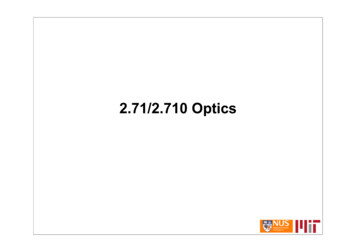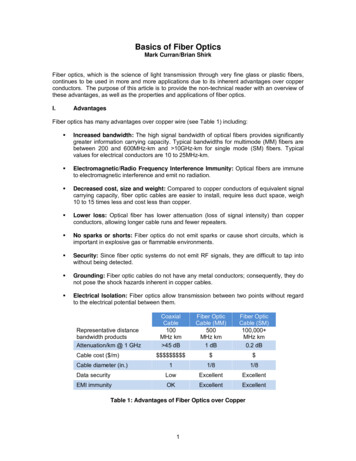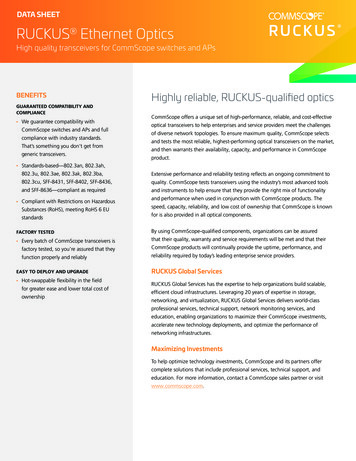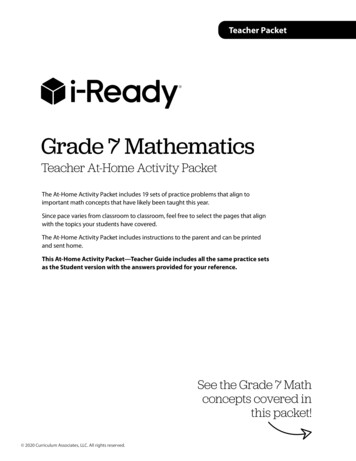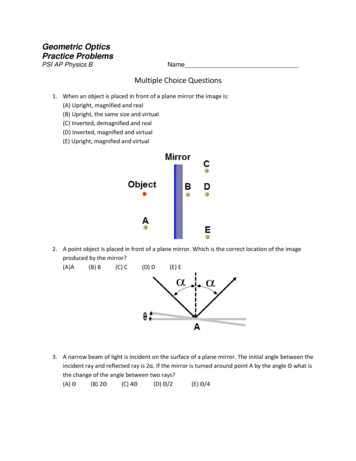
Transcription
Geometric OpticsPractice ProblemsPSI AP Physics BNameMultiple Choice Questions1. When an object is placed in front of a plane mirror the image is:(A) Upright, magnified and real(B) Upright, the same size and virtual(C) Inverted, demagnified and real(D) Inverted, magnified and virtual(E) Upright, magnified and virtual2. A point object is placed in front of a plane mirror. Which is the correct location of the imageproduced by the mirror?(A)A(B) B(C) C(D) D(E) E3. A narrow beam of light is incident on the surface of a plane mirror. The initial angle between theincident ray and reflected ray is 2α. If the mirror is turned around point A by the angle Θ what isthe change of the angle between two rays?(A) Θ(B) 2Θ(C) 4Θ(D) Θ/2(E) Θ/4
4. A candle is placed in front of a concave mirror. The image produced by the mirror is:(A) Real, inverted and magnified(B) Real, inverted and demagnified(C) Virtual, upright and magnified(D) Virtual, upright and demagnified(E) Real, upright and magnified5. A candle is placed in front of a concave mirror. The image produced by the mirror is:(A) Real, inverted and magnified(B) Real, inverted and demagnified(C) Virtual, upright and magnified(D) Virtual, upright and demagnified(E) Real, upright and magnified
6. A candle is placed in front of a concave mirror. The image produced by the mirror is:(A) Real, inverted and magnified(B) Real, inverted and demagnified(C) Virtual, upright and magnified(D) Virtual, upright and demagnified7. A candle is placed in front of a convex mirror. The image produced by the mirror is:(A) Real, inverted and magnified(B) Real, inverted and demagnified(C) Virtual, upright and magnified(D) Virtual, upright and demagnified
8. A very narrow light ray AB strikes the surface of a concave mirror as shown on the diagram.Which of the following diagrams represents the reflected ray?(A)(C)(E)(B)(D)
9. A very narrow light ray AB strikes the surface of a concave mirror as shown on the diagram.Which of the following diagrams represents the reflected ray?(A)(C)(E)(B)(D)
10. A very narrow light ray AB strikes the surface of a convex mirror as shown on the diagram.Which of the following diagrams represents the reflected ray?(A)(B)(C)(D)(E)
11. An object is located far away from a concave mirror. The image is located at:(A) The distance d R(B) The distance d F(C) The distance F d R(D) The focal point(E) More information is required12. An object is placed at the focal point in front of a concave mirror. The image is located:(A) The distance d R(B) The distance d F(C) The distance F d R(D) The focal point(E) No image is formed13. An object is placed at the center of the curvature in front of a concave mirror. The image islocated:(A) The distance d R(B) The distance d F(C) The distance F d R(D) The focal point(E) No image is formed
14. A light ray AB is incident obliquely on the surface of a glass block. Which of the followingdiagrams represents the refracted ray?(A)(C)(E)(B)(D)
15. A light ray AB passes from glass into air at an angle less than the critical angle. Which of thefollowing diagrams represents the refracted ray?(A)(B)(C)(D)(E)
16. A light ray AB passes from glass into air at the critical angle. Which of the following diagramsrepresents the refracted ray?(A)(B)(C)(D)(E)
17. A boy is trying to catch a fish from a lake. Which of the following diagrams represents the imageof the fish observed the boy?(A)(C)(E)(B)(D)
18. Which of the lens or lenses is the converging lens?(A) I and V(B) II, III and IV(C) II and III(D) III and IV(E) IV and V19. Which of the lens or lenses is the diverging lens?(A) I and V(B) II, III and IV(C) II and III(D) III and IV(E) IV and V20. An object is placed in front of a converging lens at a distance greater than 2F. The imageproduced by the lens is:(A)Real, inverted and demagnified(B)Real, inverted and magnified(C) Virtual, upright and magnified(D) Virtual, upright and demagnified(E) Virtual, inverted and magnified
21. An object is placed in front of a converging lens at a distance between F and 2F. The imageproduced by the lens is:(A)Real, inverted and demagnified(B)Real, inverted and magnified(C) Virtual, upright and magnified(D) Virtual, upright and demagnified(E) Virtual, inverted and magnified22. An object is placed in front of a converging lens at a distance less than F. The image produced bythe lens is:(A)Real, inverted and demagnified(B)Real, inverted and magnified(C) Virtual, upright and magnified(D) Virtual, upright and demagnified(E) Virtual, inverted and magnified
23. An object is placed in front of a diverging lens at a distance between F and 2F. The imageproduced by the lens is:(A)Real, inverted and demagnified(B)Real, inverted and magnified(C) Virtual, upright and magnified(D) Virtual, upright and demagnified(E) Virtual, inverted and magnified24. A light ray is incident on a glass prism with one angle of 90 ̊and the other angle θ. If θ is greaterthan the critical angle for glass-air boundary, which of the following is correct for the emergingray from the opposite face of the prism?(A)(D)(B)(C)(E)
25. A light ray is incident on a glass prism with one angle of 90 ̊and the other angle θ. If θ is less thanthe critical angle for glass-air boundary, which of the following is correct for the emerging rayfrom the opposite face of the prism?(A)(D)(B)(C)(E)
Free Response Problems1. A candle is placed at a distance of 15 cm from of a concave mirror with a focal length of 10 cm.The candle is 4 cm tall.a. On the diagram below use ray-tracing to show the image produced by themirror.b. Find the image distance. Is the image real or virtual?c. Find the size of the image. Is the image upright or inverted?d. The concave mirror is replaced by a convex mirror. On the diagram below useray-tracing to show the new image formed by the convex mirror
2. An object is placed at a distance of 60 cm from a converging lens with a focal length of 20 cm.a. On the diagram below use ray-tracing to show the image formed by the lens.b. Calculate the image distance. Is the image virtual or real?c. If the object is 10 cm tall, what is the size of the image?d. An identical converging lens is placed behind the first lens at the focal point. Onthe diagram below use ray-tracing to show the image formed by two lenses.
3. An object is placed at a distance of 80 cm from a converging lens with a focal length of 30 cm.a. On the diagram below use ray-tracing to show the image formed by the lens.b. Calculate the image distance. Is the image virtual or real?c. If the object is 8 cm tall, what is the size of the image?d. A diverging lens with the same focal length is placed behind the first lens at thepoint 3F. On the diagram below use ray-tracing to show the image formed by twolenses.
4. A light ray strikes a flat piece of glass at an angle of incidence 60 ̊. The thickness of the glass is 2cm and the index of refraction of the glass is 1.5.a. On the diagram below use ray-tracing to show the refracted ray from both facesof the glass.b. The light ray partially reflects from the surface of the glass. Find the angle ofreflection.c. Find the angle at which the ray emerges from the glass.d. Find the linear displacement between the emerging ray and the incident ray.
5. A light ray travels from glass to air at an angle of incidence θ1 35 .̊ The ray partially reflectedfrom the glass-air boundary at the angle θ2 and partially refracted at the angle θ3. The index ofrefraction of the glass is 1.6.a. What is the speed of light in glass?b. What is the angle of reflection θ2?c. What is the angle of refraction θ3?d. What is the minimum value of θ1 at which light doesn’t emerge from the topface of the glass?
6. A narrow beam of white light is incident normally on the surface of a triangular silicate flint glassprism with one angle of 90 .̊ The index of refraction for violet light is 1.66 and for red light is1.61. The angle θ in the prism is less than the critical angle for this type of glass.a. On the diagram below show an approximate sketch for the refracted light fromthe opposite face of the prism.b. Find the critical angle of the glass for both violet and red light.c. If the angle θ is 30 ̊, calculate the angular width of the dispersion spectrum.d. The situation has changed to opposite; now a beam of white light travels in ahuge glass block and strikes the surface of an air bubble in a shape of triangularprism. On the diagram below show an approximate sketch for the refracted lightfrom the opposite face of the prism.
Multiple Choice Answers1.2.3.4.5.BDBBA6.7.8.9.10.CDBACFree Response Answers1. a.b. di 30 cm; It is realc. hi 8 cm; It is 21.22.23.24.25.BCDAC
2. a.b. di 30 cm; It is realc. hi 5 cm; It is invertedd.3. a.b. di 48 cm; It is realc. hi 4.8 cmd.
4. a.b. 60Oc. 60Od. Δx 0.42 cm5. a. v 1.9 x 108 m/sb. ϴ 35Oc. ϴ 66.6Od. ϴ 38.7O6. a.b. ϴCR 38.4O; ϴCV 37Oc. Δϴ 2.5Od.
Practice Problems PSI AP Physics B Name_ Multiple Choice Questions 1. When an object is placed in front of a plane mirror the image is: (A) Upright, magnified and real (B) Upright, the same size and virtual (C) Inverted, demagnified and real (D) Inverted, magnified and virtu
